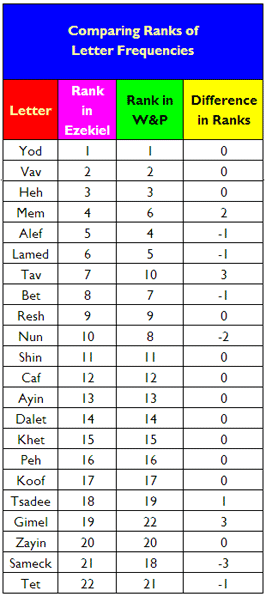| |
|
Sherman Responds to Ingermanson Posting
|
By Ed Sherman, Director, Bible Code Digest
Physicist and novelist Randy Ingermanson�s website contains the posting, �An Unbiased Search for Bible Codes.� The posting refers to an experiment that was to be conducted jointly by Ingermanson and BCD. The experiment did not proceed because Ingermanson�s second career as a novelist took off, leaving him with little time to do the requisite programming. His posting claims that this experiment would have been unbiased, and expresses the hope that someone might some day complete it.
After Ingermanson withdrew as the programmer, BCD had to decide whether to hire another programmer or to complete a different study. We opted for the latter because we concluded that the proposed experiment did not adequately focus on the phenomenon in question. A paper detailing our subsequent work and findings is posted on the BCD website.
Design Suffered
While we agree that the tabled joint experiment would have been objective, its design suffered from serious shortcomings. In the experiment a computer would search for long ELSs comprised simply of strings of Hebrew words (defined as those appearing in the Tanakh). Searches would occur in various books in the Torah and in randomly scrambled versions of those books. The number of lengthy ELSs found in the books of the Torah and the control texts would be compared and standard statistical tests would be applied.
The fundamental problem with this experiment is that the definition of an acceptable ELS is too broad. If someone were to encode a text, would they just insert strings of words that did not fit together grammatically? Although that is possible, it isn�t very plausible.
So where is the potential bias in the old joint experiment? Suppose a text is encoded with numerous lengthy ELSs in grammatically correct Hebrew. In a comparative test, these real codes would get lost among the far greater number of ELSs that only consisted of strings of Hebrew words. So any real difference in the frequency of �long� ELSs would get drowned out by the noise. The risk of a �false negative� from the old experiment is very high. A �false negative� would occur when an experiment indicates no statistically significant difference between the extent of �encoding� in the Torah and the control texts, when in actuality it did exist.
The basic problem is that the phenomenon under examination would not have been sufficiently isolated, and so potentially positive results would be seriously diluted by irrelevant results for ELSs that merely consisted of series of Hebrew words.
Total Objectivity vs. Relevance
It is natural that a physicist such as Ingermanson would place first priority on objectivity in designing an experiment. To him, eliminating any potential elements of subjectivity is a total virtue. Unfortunately, to have true relevance to the purported phenomenon of long encoded sentences and phrases, the judgment of an expert is required. So an element of subjectivity must be present. I do not believe that optimizing objectivity at the expense of relevance is a wise choice.
In designing the BCD study, we took great care to minimize potential sources of bias due to utilizing the opinions of experts. First, the Hebrew expert didn�t even know we were sending him a mixture of Hebrew letters strings from the Bible and a control text. He believed that everything we were sending him was from the Bible. Second, we retained another Hebrew expert to conduct parallel searches, thereby obtaining a second opinion.
We proceeded with the BCD study because we wanted to take a fresh look at the question of whether Bible codes were real. If they weren�t, why waste thousands of hours researching and writing about illusory codes?
Criticism Exaggerated
Ingermanson criticizes the BCD paper on the basis that the �various Hebrew letters occur with significantly different frequencies in the� Bible and in War & Peace. Because of this, he believed we were comparing apples and oranges. His criticism is exaggerated.
In the fifth paragraph after Table 1 in the paper, we stated, �The possibility that differences in letter frequencies between the two texts might account for some of the difference in discovery rates was considered. A visual comparison of the individual letter frequencies indicated a very strong similarity between the two texts. The correlation between the two sets of frequencies was quite high (0.964827).� (If there were a perfect correlation, it would be 1.0.)
We weren�t searching in the entire Hebrew Bible nor in the entire Hebrew translation of War & Peace. Instead, we searched in the book of Ezekiel and a segment of War & Peace of comparable length that also had very similar letter frequencies. It would be more accurate to say that we were comparing Valencia oranges from orchards that were a few miles apart, but not apples vs. oranges.
Here is a direct comparison of the letter frequencies in the two search texts.

Suppose we compare the ranks of the letter frequencies of the different letters. We have the following:

For 12 of the 22 letters, the frequency rank is identical. For five of the letters, the rank differs by one. For only two of the letters did the rank differ by two, and for only three of the letters did the rank differ by three. In no case does the rank differ by more than three. Those letters for which the rank was either identical or different by one accounted for 78.9% of all the letters in the Ezekiel text.
Ingermanson�s concern about differences in letter frequencies is germane to the Ezekiel/War & Peace experiment we conducted. However, it is not material to the statistical test we applied to the Ezekiel 37 cluster, and that test is the crux of the BCD paper. In that test, the difference between the expected and actual number of long ELSs is so great that the above frequency differences cannot account for it.
Results Always the Same
In the paper we dealt with the question of differing letter frequencies by examining the effects of varying the assumed probability of finding an extension to an existing ELS over a very large range. The results were always the same: the difference between the expected and actual number of long ELSs was always so large that there was virtually no possibility the difference could be due to chance.
The decision to use a segment of a Hebrew translation of War & Peace as the control text was based on three considerations. First, we wanted a control text that we believed would be acceptable to code skeptics. Since leading skeptics had used this as a control text themselves, it was a leading candidate. Second, we wanted a control text with very similar letter frequencies, and it satisfied that requirement, as discussed above. Third, we wanted a text that was generally available, making it easier for another researcher to reproduce our results. Because it is so laborious to search for long ELSs consisting of sentences with grammatically reasonable Hebrew, we didn�t have the luxury of quickly running the whole thing with different control texts.
Misinterpreted Findings
Ingermanson misinterpreted the findings of the experiment. He states, �Sherman�s experiments on the Hebrew text of War and Peace convinced him of what I had argued privately with him years earlier�that the odds were quite high of finding a number of long ELSs. In a section of War and Peace as long as Ezekiel 37, Sherman would expect to find nearly 6 ELSs with more than 25 letters! So much for his claims from a few years ago of �1 in 14 trillion� for his 22-letter ELS!� The whole point was to compare the actual with the expected number of long ELSs. The fact is that the odds are extremely remote that 33 long ELSs would be found in Ezekiel when only 6 were expected by chance. I think he missed the point.
His claim that my statements contradicted one another is invalid. He is comparing two types of probabilities that are as different as grapes and watermelons, and alleging that I had engaged in some kind of �rather extraordinary confession.� This is not true. Grapes shouldn�t be compared with watermelons, and it isn�t a confession to say that the size of a grape is different from that of a watermelon.
In terms of probabilities of the random occurrence of codes, grapes differ from watermelons in terms of issues such as whether alternative ELSs would need to have a similar level of topical relevance, logical content and appropriateness to the context of the literal passage. Or would �comparable� ELSs include the enormous group of ELSs that only met the minimal standard of consisting of grammatically reasonable Hebrew? It makes a tremendous difference.
We previously described at length the relevance of the 22-letter ELS, �Gushing from Above, Jesus is My Mighty Name, and the Clouds Rejoiced,� in the first section of our report, for the benefit of those who may not be familiar with the Biblical symbols in this code.
I do not believe that any of the comments in Ingermanson�s posting point out a need to revise the study we did or the paper describing it. We stand by our work.
|
Enjoy finding your own Bible codes.
Bible code search software is available in our online store.
Subscribe Free! Sign Up Today!
Become a member of the non-profit Isaac Newton Bible Code Research Society.
Not only will you be part of the world's leading organization researching and publicizing Bible and Torah codes, but you will receive Bible Code Digest absolutely free, including . . .
- Latest Bible Code News
- Easy-to-Understand Bible Code Feature Articles
- Exciting Inside Information from Leading Code Researchers
- Details of Great New Discoveries
- Summaries of the Latest Battles Between Code Proponents and Skeptics
Stay current on Bible code news. Be first to hear about all of the latest Bible code discoveries.
Sign up to receive Bible Code Digest today.
|
|







Click here
and sign up to receive Bible Code Digest with no cost or obligation.
 Code Skeptics' Arguments Trashed Ever since the first Bible codes were announced, skeptics have been saying, "Oh, well, you can also find codes like that in books like War and Peace and Moby Dick."
We took the time to examine this notion and the best example of it that the skeptics have been able to come up with. The results of our research have completely blown away their theory.
Click here to see for yourself.
NEW: Second Study Undermines
Skeptics' Main Objection
to Codes
Click here for report |











